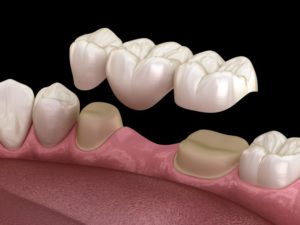
If you’re missing one or more teeth, your dentist may recommend a dental bridge.
What is a dental bridge?
Dental bridges are fixed devices that bridge the gap created by one or more missing teeth.
What are the types of dental bridges?
The following are the 3 main types of dental bridges:
- Traditional – A crown or implant is placed for the tooth on each side of the gap created by the missing tooth, with a false tooth called a pontic placed in the gap. This is the most common type of bridge and is made of either ceramics or of porcelain fused to metal.
- Cantilever – These are used when adjacent teeth are only on one side of the missing tooth or teeth.
- Maryland bonded – This type of bridge has a framework as well as wings that are often on just one side of the bridge and are bonded to existing teeth. It’s usually used for missing front teeth.
Why do I need a dental bridge?
A dental bridge helps bridge the gap before one or more missing teeth and accomplishes the following:
- Restores your smile
- Enables you to chew and speak normally
- Keeps your face from looking sunken where the tooth or teeth is missing
- Helps distribute the forces in your bite properly by replacing missing teeth
- Keeps other teeth from drifting out of position
Are dental bridges permanent?
Dental bridges are not permanent. They last an average of 10 years.
Is dental bridge better than an implant?
A dental implant uses a titanium post to act as a tooth root that supports a crown. The post fuses into the jawbone after several months, and an abutment is then attached to the post frame. The dental crown is attached into it by using screws or cement.
Your dentist can talk with you about whether an implant or a bridge is recommended in your particular case. In general, the following are some differences between implants and bridges.
Implants
- Look more natural, so they’re usually recommended if a tooth is missing in the front
- Prevent the jawbone from deteriorating
Bridges
- Can be provided more quickly
- Are less expensive
Can a dental bridge be removed and recemented?
Bridges can have issues for a variety of reasons, and in some cases, they can be removed and recemented.
Can a dental bridge fall out?
A dental bridge can fall out for reasons including decay under or around the bridge and an irregular bite pattern around the bridge, which creates pressure points.
Can you eat with dental bridges?
You can eat with dental bridges, but you should also practice good oral hygiene so food doesn’t get stuck between teeth or under your false tooth.
How do you clean a removable dental bridge?
A removable dental bridge is a partial denture that replaces missing teeth. It should be cleaned using the following steps:
- Stand over a towel or sink full of water.
- Brush your bridge with a soft-bristled toothbrush or denture cleaner.
- Rinse with cool water.
What are the disadvantages of dental bridge?
Teeth must be filed down to accommodate your dental bridge. In addition, dental bridges can collapse if your supporting teeth aren’t strong enough. They can also be difficult to clean and will eventually need to be replaced.
If you’d like to find out more about dental bridges, make an appointment today with Cedar Mountain Dental in Newington, CT.

